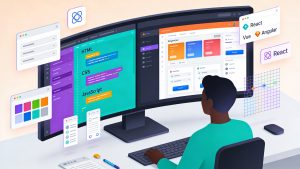In today’s rapidly evolving tech landscape, the demand for full stack developers has reached new heights. Organizations are actively seeking professionals who can manage both the frontend and backend of web applications, making this career path highly attractive for those looking to break into the industry.
The Rise of Full Stack Development
Full stack development refers to the creation of both the client-facing and server-side components of web applications. The frontend is responsible for user experience and interface, while the backend handles logic, data management, and integration with other services. This dual expertise allows developers to build complete, scalable solutions from scratch.
Who Is a Full Stack Developer?
A full stack developer possesses the skills to design, develop, and maintain every layer of a web application. From crafting intuitive user interfaces to building robust server logic and managing databases, these professionals oversee entire projects from conception to deployment. Their versatility makes them invaluable to teams and organizations aiming for efficient, end-to-end development.
Key Responsibilities:
- Collaborating with designers to create seamless web experiences
- Continuously improving software through testing and debugging
- Building and maintaining databases and servers
- Designing responsive, user-friendly applications
- Leveraging advanced technologies for performance optimization
- Communicating with clients to gather feedback and refine solutions
The 2025 Full Stack Developer Roadmap
Aspiring developers can follow a structured path to gain the skills needed for a successful full stack career. Below is a step-by-step guide to mastering the essential technologies and practices in 2025:
Step 1: Master the Fundamentals
- Learn HTML, CSS, and JavaScript for web structure, styling, and interactivity.
- Build a solid foundation in responsive design and accessibility.
Step 2: Version Control
- Get comfortable with Git for tracking changes and collaborating on code.
Step 3: Frontend Frameworks
- Gain hands-on experience with React, Angular, or Vue.js.
- Develop small projects to reinforce your understanding.
Step 4: Server-Side Programming
- Learn backend languages such as Node.js, Python, or Ruby.
- Understand server-side scripting, request handling, and database operations.
Step 5: Database Management
- Explore SQL (MySQL, PostgreSQL) and NoSQL (MongoDB) databases.
- Practice CRUD operations and data modeling.
Step 6: RESTful APIs
- Build and consume APIs using HTTP methods.
- Learn about authentication, authorization, and API security.
Step 7: Backend Frameworks
- Work with frameworks like Express.js, Django, or Ruby on Rails.
- Understand routing, middleware, and integration with databases.
Step 8: Web Security
- Study common vulnerabilities such as CSRF and XSS.
- Implement secure authentication and data protection practices.
Step 9: DevOps and Deployment
- Learn about Docker, Kubernetes, and cloud platforms for deployment.
- Understand CI/CD pipelines for automated testing and deployment.
Step 10: Advanced Tools and Libraries
- Explore tools like Sass, Redux, and TypeScript.
- Experiment with serverless architectures and microservices.
Step 11: Build Real-World Projects
- Create full stack applications that showcase your skills.
- Develop a portfolio website to present your work to employers.
Step 12: Continuous Learning
- Stay updated with the latest trends, frameworks, and best practices.
- Join online communities, attend webinars, and read industry blogs.
Step 13: Sharpen Soft Skills
- Improve problem-solving through coding challenges and hackathons.
- Enhance communication and teamwork by participating in code reviews and collaborative projects.
Why a Roadmap Matters
A well-defined roadmap provides structure, clarity, and motivation for aspiring developers. It helps prioritize learning, track progress, and set achievable goals. By following a strategic plan, individuals can efficiently navigate the complexities of full stack development and adapt to evolving technologies.
Essential Frameworks and Technologies for 2025
| Frontend Frameworks | Backend Frameworks | Databases |
|---|---|---|
| React | Express.js | MongoDB |
| Angular | Django | PostgreSQL |
| Vue.js | Ruby on Rails | MySQL |
| Next.js | Spring Boot | SQLite |
These frameworks are widely adopted in the industry for their scalability, performance, and community support. Mastery of one or more can significantly enhance a developer’s employability.
Frequently Asked Questions
What is full stack development?
Full stack development involves building both the client-side and server-side components of web applications.
How long does it take to learn full stack development?
On average, it takes 3 to 6 months to master the core concepts, depending on prior experience and dedication.
Which technology stack is best for beginners?
The MERN (MongoDB, Express.js, React, Node.js) and MEAN (MongoDB, Express.js, Angular, Node.js) stacks are recommended for their unified JavaScript ecosystem and community resources.
What soft skills are needed?
Time management, adaptability, continuous learning, problem-solving, and teamwork are crucial for success in this field.
How can aspiring developers stay updated?
By joining online communities, following reputable tech blogs, attending webinars, and participating in industry events.
Conclusion
The journey to becoming a full stack developer in 2025 is both challenging and rewarding. With the right roadmap, dedication, and a commitment to continuous learning, anyone can master the art of building complete web applications. This career path not only offers lucrative opportunities but also empowers professionals to innovate and drive the future of technology.
Read more such articles from our Newsletter here.



